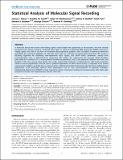Statistical Analysis of Molecular Signal Recording
Author(s)
Glaser, Joshua I.; Zamft, Bradley M.; Marblestone, Adam Henry; Moffitt, Jeffrey R.; Tyo, Keith; Church, George M.; Kording, Konrad P.; Boyden, Edward; ... Show more Show less
DownloadGlaser-2013-Statistical Analysis.pdf (763.4Kb)
PUBLISHER_CC
Publisher with Creative Commons License
Creative Commons Attribution
Terms of use
Metadata
Show full item recordAbstract
A molecular device that records time-varying signals would enable new approaches in neuroscience. We have recently proposed such a device, termed a “molecular ticker tape”, in which an engineered DNA polymerase (DNAP) writes time-varying signals into DNA in the form of nucleotide misincorporation patterns. Here, we define a theoretical framework quantifying the expected capabilities of molecular ticker tapes as a function of experimental parameters. We present a decoding algorithm for estimating time-dependent input signals, and DNAP kinetic parameters, directly from misincorporation rates as determined by sequencing. We explore the requirements for accurate signal decoding, particularly the constraints on (1) the polymerase biochemical parameters, and (2) the amplitude, temporal resolution, and duration of the time-varying input signals. Our results suggest that molecular recording devices with kinetic properties similar to natural polymerases could be used to perform experiments in which neural activity is compared across several experimental conditions, and that devices engineered by combining favorable biochemical properties from multiple known polymerases could potentially measure faster phenomena such as slow synchronization of neuronal oscillations. Sophisticated engineering of DNAPs is likely required to achieve molecular recording of neuronal activity with single-spike temporal resolution over experimentally relevant timescales.
Date issued
2013-07Department
Massachusetts Institute of Technology. Department of Biological Engineering; Massachusetts Institute of Technology. Media Laboratory; McGovern Institute for Brain Research at MIT; Program in Media Arts and Sciences (Massachusetts Institute of Technology)Journal
PLoS Computational Biology
Publisher
Public Library of Science
Citation
Glaser, Joshua I., Bradley M. Zamft, Adam H. Marblestone, Jeffrey R. Moffitt, Keith Tyo, Edward S. Boyden, George Church, and Konrad P. Kording. “Statistical Analysis of Molecular Signal Recording.” Edited by Scott Markel. PLoS Computational Biology 9, no. 7 (July 18, 2013): e1003145.
Version: Final published version
ISSN
1553-7358
1553-734X